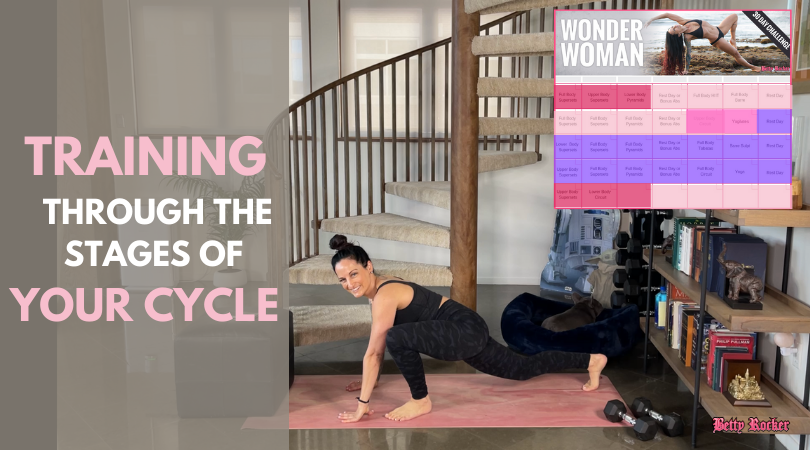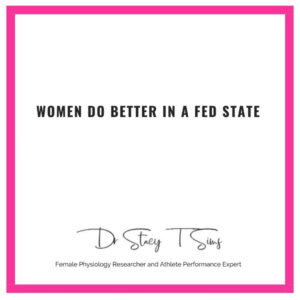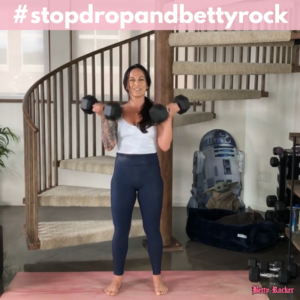
In this article:
- Your cycle as an advantage
- Continuing education opportunities and resources to learn more about cycle training
- The phases of a natural menstrual cycle
- Training considerations and tips for each phase of the menstrual cycle
- Nutrition considerations and resources
- Considerations for those using an oral contraceptive pill
- Peri and post-menopause considerations and training tips
Your cycle as an advantage

If you’ve reached the life stage where your period has slowed down or stopped, you’re likely also noticing changes in your energy, drive and body composition. All of these changes, including the cyclical nature of our energy when we’re still having regular periods, are related to the interplay of key hormones – notably estrogen and progesterone, and their impact on every cell in our body.
I was very curious about this topic, as I noticed shifts in my energy when it came to working out over the course of the month. As I have so many women readers who are in their peri and post-menopause years (not to mention I’m heading that way myself) I was also very interested in what adaptations we can make at that life stage as well.
To learn about the science of our cycle and the training advantages it provides for women, I took a continuing education course for coaches and trainers (appropriate for anyone interested in learning this material) with Dr. Stacy Sims, a renowned scientist and researcher who studies sex differences in fitness and nutrition.

This can lead to feelings of inadequacy or shame when we feel tired, are bleeding, or are in other ways impacted by the natural rhythms we experience – rather than identifying our physiology as unique, and ourselves as badass women who have a complex system that requires space for the ebb and flow of our energy.
When I learned how all this works, it was a joy to begin to practice and I felt the impacts quickly.
Not only did I enjoy pushing hard when I naturally had the drive to do so, I gave myself permission to go slower and restore myself. I felt better physically and mentally as a pressure I didn’t even realize I was putting on myself was lifted.

I found it was easy to make minor adjustments to any training program and suit where I was at in my cycle – and I expect you’ll be able to do the same (examples included below!).
Since we’re all going to have variations in our cycle length and phase length, and may be in different stages of our life cycle (i.e. menstrual, peri-menopause or post-menopause), it is best to learn about the different stages so you can apply it to yourself individually.
Don’t worry if a program isn’t written “for your cycle” – with this information you can use any program and make it right for you wherever you’re at. You can use the Wild.ai app to track your cycle and get training and nutrition tips for where you’re at – developed by Dr Sims and her team!
For more in depth on these topics, check out Dr. Sims’ website and courses, and the 2-part podcast interview I did with her where she summarizes training and nutrition considerations during our menstrual years, during post menopause, and discusses training considerations for those on the pill and using an IUD, and much more.
- Part 1: Eating and Training with your cycle with Dr. Stacy Sims
- Part 2: Eating and Training with your cycle with Dr. Stacy Sims
Let’s start by understanding how our natural cycle looks, and considering the length of each of YOUR phases.

In the diagram below a “textbook” menstrual cycle of 28 days is represented. While it is helpful to see the phases broken out, keep in mind that the length of women’s menstrual cycles and the phases it contains actually varies. For instance, you may have a 3 day period, or a 5 day period (bleed). You may ovulate on day 12 or on day 15, which changes the length of your follicular phase.
Some women have a longer cycle of 35-40 days total, while others have a cycle as short as 21 days. Both ends of the spectrum and everything in between are considered normal.
Normal Menstrual Cycle

Tracking your cycle
Knowing when you ovulate and knowing when you menstruate will help you determine the type of training that will benefit you the most during each phase of your cycle, and determine the length of each phase. This is why you shouldn’t blanket apply a “4-week” or “28 day” training cycle to yourself if your menstrual cycle isn’t 28 days long.
Track the length of your entire cycle – from when your period starts to when your next period begins (helpful to do monthly)
- Track the length of your period, and how long your low hormone phase (follicular phase) is – which goes from when you begin your period until you ovulate.
- Track ovulation, either by getting body temperature readings from a device like this, or using a urine analysis tracker like Clearblue, Pregmate, or other. As of this post release, the Oura ring 3rd generation which is currently in release contains an upgraded operating system and more sensitive metrics which help predict ovulation and track our cycle – I’ll be reporting back on my findings once I get my new ring to let you know how accurate this is.
- Track the length of your high hormone phase (luteal phase), which is just after ovulation until your period begins again.
Tracking your cycle is a great way to start to know which phase of it you’re in so you can start using this information to optimize your nutrition and training.
The Follicular phase, also known as the “low hormone phase” is from the start of your period until ovulation.
Your uterine lining starts to thicken, waiting for a fertilized egg to implant. Estrogen rises, and is higher than progesterone meaning your body is well set up to increase muscle mass. Your core temperature is in a normal range, helping you get deep, restorative sleep.
This segment of your cycle is called the “low hormone phase” because in contrast to the luteal phase where both estrogen and progesterone are elevated, only estrogen is elevated in this segment and it tapers up.
Progesterone increases protein breakdown where estrogen is anabolic – meaning it helps increase lean mass. This is why in the first half of your cycle when estrogen predominates over progesterone, you have a greater opportunity for gains in your training and can more efficiently build muscle.
Training in the low hormone phase is all about strength and power. You may hit PR’s (personal records), have great energy to push harder and farther, and can work on upping your weight in your resistance training.
- This is assuming you are eating enough to support your training, prioritizing your sleep, and not allowing stress to overwhelm you.
- If you’re taking a Betty Rocker challenge or program, this is the phase of your cycle to give it your all. Try moves you haven’t been able to do before.
- Up your resistance. Go hard, and go longer if you have time by adding an additional round to the workout, or even repeating the entire workout if it’s shorter and you still have energy.
- During this phase of your cycle, you can really go for it with endurance, strength and power-type workouts. That could be high intensity interval training (HIIT), resistance training, or any type of more challenging, high-volume activity.

Ovulation
FSH (follicle stimulating hormone) and LH (luteinizing hormone) peak, causing the release of an egg from the ovary. Just prior to ovulation estrogen peaks then drops off. Progesterone begins to rise.
- Training: During the short ovulation window, you can generally continue to go hard in your training (unless your energy feels low for any reason).
- Similar to the low hormone/follicular phase, you can continue to do endurance or strength and power type workouts. That could be high intensity interval training, resistance training, or any type of more challenging activity.
- If you experience an energy drop however, listen to your body and back off on intensity.
The Luteal Phase, also known as the “high hormone phase” occurs after ovulation.
The egg travels down the fallopian tube towards the uterus, where it will attach to the uterine lining and may be fertilized.
Progesterone is increasingly heightened, and is now the dominant player in relation to estrogen, however estrogen still has a presence.
Progesterone increases our respiration rate. It alters the sweat threshold and has a thermogenic effect. As it rises in the luteal phase, it elevates our core temperature as much as 0.5 C. This can impact sleep – as in it becomes harder in the second half of your cycle to get that good, deep sleep.
Training: After ovulation, it’s ideal to begin to monitor your energy and stamina as the rise in progesterone will impact your recovery and ability to push hard in your workouts. Personally, I experience this gradually over the first week post-ovulation.
- You can taper your training down in intensity in whatever way feels natural to you, and even focus on more steady state cardiovascular training.
- Simply having the mindset that the body is shifting has been tremendously helpful to me – knowing that I don’t have to have the same expectation of my output in the luteal phase helps me shift easily into training adaptations that feel good to my body.
- For instance, if I’m weight training I might start the workout with a heavier load, and decrease the weight amount as I go through subsequent rounds (reverse pyramid training).
- I might also simply use less resistance altogether, and do higher reps, do bodyweight training, or do the low-impact version of more high intensity moves and focus more on form.
- I might also opt for a steady state cardiovascular workout on some of the days I was doing more high impact training in the follicular phase.
- In the latter part of the luteal phase (days 5-7 or so before your period depending on your cycle length), you may feel a little more fatigued, due to estrogen and progesterone crossing to the brain and effecting the central nervous system. It’s a great time to really lower the resistance (weight), focus on technique drills, and swap in more mobility and functional movement skills classes.
- This is a good time for maintenance and recovery type sessions, slow, recuperative movement, and less cardio-focused workouts. That might be yoga, functional movement drills, bodyweight low impact training, or anything that feels restorative to you.

When it comes to a 4 week program like the example, remember that how you feel throughout the challenge has to do with where you’re at in your cycle, and that if you start the challenge during the follicular phase of your cycle (menstruation through ovulation) you may experience a drop of energy after you ovulate and move into the luteal phase – which could be closer to the end of the challenge.
Listen to your body and adapt if your energy is dropping during any point in the challenge program.
- You can supplement with workouts from the Class Library (available in the member’s area in Rock Your Life, over 1000 classes to choose from) and swap in a few days of mobility or yoga if you’re not feeling up for a strength and power workout (which is recommended in the days leading up to your period as you’re in the tail end of the luteal phase).
- You can also do the prescribed workout and give yourself permission to move more slowly, use less intensity or resistance, and even do less rounds.
- Just because you’re at the end of a program doesn’t mean you’re always supposed to be “going harder” than you did at the start. If the end of a challenge lines up with when you’re in your luteal phase, give yourself space to back off.

Menstruation
While this is technically at the start of your cycle and included in the follicular phase, I’ve listed it last as it makes a bit more sense once you understand all the other stages of your cycle.
This is represented above in the diagram at the beginning of the chart and estrogen and progesterone are lowered after the end of the previous cycle, signaling blood and tissues lining the uterus to break down and shed from the body.
You may have less energy during your bleeding time than after it stops, but many women begin to feel more energized as progesterone drops down, reducing their core temperature and estrogen once again takes a front seat.
- Training: This is really up to you. If you feel tired, do more gentle movement and things that feel restorative throughout menstruation – similar to what you were doing leading up to it.
- If you begin to feel energized and strong, you can begin training at a volume that suits you, like we talked about with the follicular phase.
- This can be a transitionary phase, and you may shift through feeling low energy to higher energy over the course of your bleed as your body starts to feel the effects of the low hormone phase. Listen to your body and stay nourished, hydrated, and rested.
- Check out this great “Period Power” article from Dr. Sims about training with your period.
Nutrition considerations and resources
One of the most essential things to consider when you’re training regularly is that you are adequately fueled for your training. Going into your workouts fueled is going to allow for adaptations and energy output, and help you preserve the lean mass you have so you can build more.

You also want to be fueling post-workout with protein and carbohydrates as soon as possible to stop the catabolism of our muscle tissue. Dr. Sims recommends fueling up between 30-45 minutes post-workout. Your body won’t start repairing until you’ve had some food.
Your body needs enough amino acids for muscle protein synthesis, not to mention enzyme and hormone function, brain health and your immune system.
The essential amino acid leucine is integral to muscle protein synthesis, and ensuring that you have enough of this amino acid (along with all the essential aminos that your body cannot make on its own) will certainly support your training goals.
As a result, prioritize your protein intake through your entire cycle – aiming for at least 20-30 grams of protein per meal if you’re under 40, and between 30-40 grams per meal if you’re over 40.
I use a protein powder like I ❤️ Vanilla Protein to boost the protein content of my breakfast foods, as a shake post workout, or even if I’m going to do a morning workout and need a little fuel going into it to help me access my best output.
Because I tend to perform best an hour or so after a meal, I like to work out an hour or so after breakfast, and have a protein shake with fruit afterwards. Just like the protein from whole foods, a protein powder has to break down after you ingest it for your body to access the amino acids.

In their free form, aminos do not have to be broken down, making them a great supplement to support you during your workout, and also help improve recovery.
This prioritization of protein is especially important in the high hormone phase (after you ovulate) as your body is in a continuous breakdown state with elevated cortisol and progesterone, breaking down more tissue. Be sure you’re adding protein to each meal, and consider using a quality protein shake to conveniently boost your daily intake.
Prioritizing quality, complex carbohydrates around your training (and quick carbs during your training for longer training sessions) is essential for both recovery and energy to push through your workouts.
Dr. Sims and I discuss our needs for protein, carbohydrates and fat in this podcast and I highly recommend this resource.

I recommend checking out:
- Are you undernourished?
- Yes, you are an athlete – no, you shouldn’t practice intermittent fasting
- As well as our conversation about fasting and the keto diet as they relate to women in part 2 of our interview on The Betty Rocker Show podcast.
Considerations for training if you’re on the pill
An oral contraceptive pill (OCP) will modify your body’s natural estrogen and progesterone cycling by delivering a low dose of hormones on a daily basis. The week that you are on the sugar pill is the week your body bleeds, but it is not the same as regular menstruation.

- Training: Because of the variation from what your body would do naturally you can still “periodize” your training by doing more high-volume training in the first 3 weeks, and backing off during the sugar pill week that you bleed.
For more on how the pill impacts your training capacity, read this article from Dr. Stacy Sims, and listen to the interviews I did with her on The Betty Rocker Show, parts 1 and 2. To learn even more about the pill and how it impacts your body, check out the podcast interview with Dr. Jolene Brighten.
Perimenopause and post-menopause considerations and training tips
When we get into peri-menopause (the period of time leading up to menopause), our cycle length may become a bit erratic as we stop ovulating on the same schedule and our hormone levels fluctuate in response. We don’t get the same length of low and high hormone phases, and your period may come at unexpected times.
In menopause, we no longer ovulate and our estrogen and progesterone flatline. In both of these stages of life, specific training adaptations are recommended to help you navigate these fluctuations and stay strong, or even build strength.
Menstrual Cycle in the years before and after menopause

- Training: One of the essential pieces of your training during this stage of life is to avoid what Dr. Sims calls the “grey zone.” This is what we get into when we don’t take adequate rest and instead are pushing ourselves to exercise day after day.
Without proper rest, we can never hit truly high intensities in the workouts that we do, because we’re never fully recovered.
- And this is the stage of life when we want to be hitting those high intensities, both with high intensity interval training (HIIT) style workouts, and ramping up the resistance training to add more load to the body.
- Both of these types of higher volume training force adaptations that will enable us to maintain and build lean mass. But we must be properly rested to take advantage of these adaptations.
- Because we no longer have the fluctuations of estrogen and progesterone to drive lean mass development, we need to increase the training stimulus in other ways.
- Sleep and hot flashes: I would also recommend prioritizing sleep (see this article for some great tips) and using a Chilipad mattress topper during peri-menopause to regulate body temperature and improve deep, restorative rest. In her Women are Not Small Men course, Dr. Sims discussed improving your heat tolerance by using a sauna, something you can try out to help your body acclimate to hot flashes more easily.
- Nutrition: It’s even more essential than ever to focus on protein intake, prioritizing leucine (one of the essential amino acids responsible for muscle protein synthesis) as we stop absorbing aminos as readily in our 40’s and beyond. So increasing protein to 30-40 grams per meal, prioritizing being adequately fueled before and after training, and focusing on fruit and vegetable sources of carbohydrates and minimizing sugar intake will all support a leaner body composition and improve training results.
While this article is far from comprehensive, I hope it has given you a good foundation to build upon. I’m practicing this myself by tracking my cycle each month, and using where I’m at to be more adaptable with my training.
If you’re interested in learning more from Dr. Stacy Sims, follow her on Instagram – she posts so many great and informative posts, and releases excellent content on her website as well. Check out her course offerings, too – she has a menopause course as well, and a membership where she regularly puts out new modules and content from her research and from new research available.
Thanks for taking the time to read through this today, and I wish you nothing but success as you navigate life in your amazing female physique!
 Training in the low hormone phase is all about strength and power. You may hit PR’s (personal records), have great energy to push harder and farther, and can work on upping your weight in your resistance training.
Training in the low hormone phase is all about strength and power. You may hit PR’s (personal records), have great energy to push harder and farther, and can work on upping your weight in your resistance training. Training: After ovulation, it’s ideal to begin to monitor your energy and stamina as the rise in progesterone will impact your recovery and ability to push hard in your workouts. Personally, I experience this gradually over the first week post-ovulation.
Training: After ovulation, it’s ideal to begin to monitor your energy and stamina as the rise in progesterone will impact your recovery and ability to push hard in your workouts. Personally, I experience this gradually over the first week post-ovulation. Listen to your body and adapt if your energy is dropping during any point in the challenge program.
Listen to your body and adapt if your energy is dropping during any point in the challenge program.